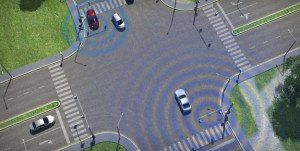Utah is test-driving new technology that could improve safety and fuel efficiency for big-rig truckers.
The Utah Department of Transportation started conducting field tests Friday of a vehicle-to-vehicle communication system aimed at the trucking industry. The tests were done in Tooele County with two semitrailers on I-80.
Developed by California-based Peloton Technology, the system lets trucks “platoon” together. Two trucks within 40 to 60 feet of each other will be able to simultaneously brake, accelerate and react to road hazards as far as 800 feet away, according to data engineering lead John Jacobs. The new technology monitors travel and operational data that can reduce driver reaction time and lower fuel costs, the Deseret News reported.
“We’ll have one truck driving ahead that is in complete control of the driving,” he said. “The rear vehicle uses a combination of sensors, including radar, high precision (global positioning satellites), a camera and two-way communications between the truck to get a precise idea of the location of the front truck.”

Jacobs believes it could lower fuel costs for big-rig drivers up to 10 percent. The system analyzes various pieces of data to find the best driving pace for the “platoon.” It also uses radar-based active braking systems and algorithms to link the trucks. It is similar to adaptive cruise control but drivers are in control of the steering.
The technology is being tested with other agencies around the U.S., said Peoloton founder Steve Body. The system could be a source of savings for large fleet operators, which spend 40 percent of operating costs on fuel.
“We’re aiming that the systems may come in at about $2,000 per truck,” Boyd said. “The return on investment could be paid off in less than one year.”
He projects it to be in limited fleet use next year and then expand in 2017.
The Utah Legislature passed legislation this year to allow testing of connected vehicles on non-urban interstates. UDOT officials say there is a shift in transportation that the state must be prepared for.
“(This kind of system) is just helping to move the entire technological front forward,” UDOT program manager Blaine Leonard said. “There is the safety issue – of making sure that as we increase how much freight is moving on our highways, systems like this can help prevent crashes and be safer (overall).”
Was this article valuable?
Here are more articles you may enjoy.

 LA Fires Push Insurers’ 2025 Disaster Losses to $107 Billion
LA Fires Push Insurers’ 2025 Disaster Losses to $107 Billion  Instacart to Pay $60 Million in FTC Consumer Protection Case
Instacart to Pay $60 Million in FTC Consumer Protection Case  Abbott Presses Congress for Shield Over Preemie Baby Formula Litigation That Could Cost It Billions
Abbott Presses Congress for Shield Over Preemie Baby Formula Litigation That Could Cost It Billions  Trump Sues BBC for $10 Billion Over Documentary Edit
Trump Sues BBC for $10 Billion Over Documentary Edit 